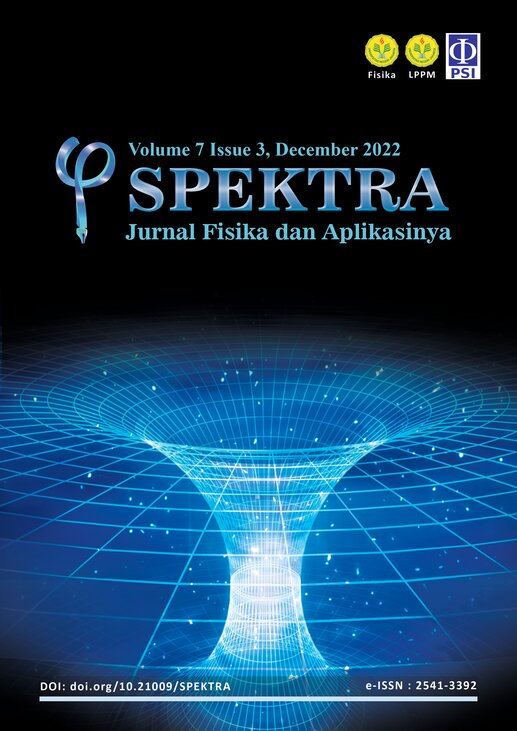FABRICATION OF PLASTIC SCINTILLATOR USING POLYSTYRENE MATRIX BASED
DOI:
https://doi.org/10.21009/SPEKTRA.073.03Keywords:
plastic scintillator, polystyrene, a fluorescent compound, extrusionAbstract
Experiments on making a plastic scintillator with polystyrene as a base material mixed with fluorescent compounds (primary and secondary dopants) have been performed. Primary dopants (PTP) used to produce emission at wavelengths of visible light and secondary dopants (POPOP) to shift the visible wavelengths to wavelengths that could be detected by Photomultiplier Tube (PMT) ) were carried out. Experiments were performed on the melting points condition of these materials, which had previously been subjected to a thermo-mechanical analysis using a Thermogravimetric Analysis-Differential Scanning Calorimetry (TGA-DSC) machine, where the melting point was in the range of 200-240°C. Furthermore, the fabrication was carried out using the extrusion technique, where polystyrene pellets mixed with PTP (1.5% by weight) and POPOP (0.05% by weight) were fed into an extrusion machine which has four hot areas to obtain a thin plate plastic scintillator. The plates were then analyzed with a UV-Vis Spectrophotometer to determine the absorption spectrum and Fluorescence Spectrophotometer to determine the emission spectrum. From the results of the analysis, it was found that the samples that went through scintillation pellets and without the addition of antioxidants had absorption spectrum data of 330 nm and emission spectrum of 421 nm. These values are in accordance with the characteristics of plastic scintillators on the market.
References
[2] T. J. Hajagos et al., “High-Z Sensitized Plastic Scintillators : A Review,” Advanced Materials, vol. 30, no. 27, 2018.
[3] C. H. Lee et al., “Characteristics of Plastic Scintillators Fabricated by a Polymerization Reaction,” Nuclear Engineering and Technology, vol. 49, no. 3, pp. 592-597, 2017.
[4] J. Zhu et al., “The impact of fluorescent dyes on the performances of polystyrene-based plastic scintillators,” Nuclear Instruments and Methods in Physics Research Section A: Accelerators, Spectrometers, Detectors and Associated Equipment, vol. 835, pp. 136-141, 2016.
[5] A. Frelin et al., “Comparative Study of Plastic Scintillators for Dosimetric Applications,” IEEE Transactions on Nuclear Science, vol. 55, no. 5, pp. 2749-2756, 2008.
[6] J. B. Birks, “The Theory and Practice of Scintillation Counting,” International series of monographs in electronics and instrumentation, Elsevier, vol. 27, 2013.
[7] C. A. Whittaker et al., “Evaluating the energy dependence of various polystyrene based plastic scintillators,” Radiation Measurements, vol. 122, pp. 57-62, 2019.
[8] T. Ardiyati et al., “PENGKAJIAN TEKNOLOGI PEMBUATAN DETEKTOR PLASTIK SINTILASI,” PRIMA-Aplikasi dan Rekayasa dalam Bidang Iptek Nuklir, vol. 17, no. 1, pp. 50-57, 2020.
[9] R. Rahmanifard et al., “Synthesis and development of a vinyltoluene-based plastic scintillator,” Journal of Luminescence, vol. 194, pp. 456-460, 2018.
[10] A. Pla-dalmau, A. D. Bross and K. L. Mellott, “Low-cost extruded plastic scintillator,” Nucl. Instruments Methods Phys. Res. Sect. A Accel. Spectrometers, Detect. Assoc. Equip., vol. 466, no. 3, pp. 482-491, 2001.
[11] J. Yang and N. Hedin, “Advances of lab-scale analytical methods for solidification/stabilization technologies,” in Low Carbon Stabilization and Solidification of Hazardous Wastes, Elsivier, pp. 483-495, 2022.
[12] A. Wieczorek, “Development of novel plastic scintillators based on polyvinyltoluene for the hybrid J-PET / MR tomograph,” Jagiellonian University, 2017.
[13] C. Dujardin and M. Hamel, “Introduction-Overview on Plastic and Inorganic Scintillators,” in Plastic Scintillators, Topics in Applied Physics Springer Nature Switzerland, pp. 3-33, 2021.
[14] Saint-Gobain Crystal, “Organic Scintillation Materials and Assemblies,” 2021.
[15] Radcore-Amcrys, “Scintillation Materials and Detectors,” 2008.
Downloads
Published
How to Cite
Issue
Section
License
SPEKTRA: Jurnal Fisika dan Aplikasinya allow the author(s) to hold the copyright without restrictions and allow the author(s) to retain publishing rights without restrictions. SPEKTRA: Jurnal Fisika dan Aplikasinya CC-BY or an equivalent license as the optimal license for the publication, distribution, use, and reuse of scholarly work. In developing strategy and setting priorities, SPEKTRA: Jurnal Fisika dan Aplikasinya recognize that free access is better than priced access, libre access is better than free access, and libre under CC-BY or the equivalent is better than libre under more restrictive open licenses. We should achieve what we can when we can. We should not delay achieving free in order to achieve libre, and we should not stop with free when we can achieve libre.
 SPEKTRA: Jurnal Fisika dan Aplikasinya is licensed under a Creative Commons Attribution 4.0 International License.
SPEKTRA: Jurnal Fisika dan Aplikasinya is licensed under a Creative Commons Attribution 4.0 International License.
You are free to:
Share - copy and redistribute the material in any medium or format
Adapt - remix, transform, and build upon the material for any purpose, even commercially.
The licensor cannot revoke these freedoms as long as you follow the license terms.

 E-ISSN 2541-3392
E-ISSN 2541-3392  Focus & Scope
Focus & Scope  Editorial Team
Editorial Team  Reviewer Team
Reviewer Team  Author Guidelines
Author Guidelines  Article Template
Article Template  Author Fee
Author Fee  Publication Ethics
Publication Ethics  Plagiarism Policy
Plagiarism Policy  Open Access Policy
Open Access Policy  Peer Review Process
Peer Review Process  Retraction & Correction
Retraction & Correction  Licensing & Copyright
Licensing & Copyright  Archiving & Repository
Archiving & Repository  Contact
Contact  Mendeley
Mendeley 

